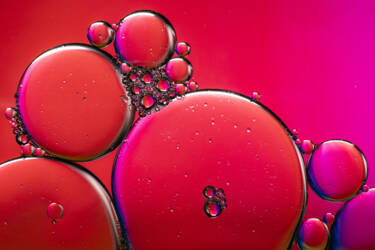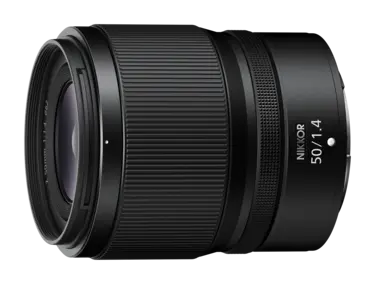Improve your close-up photography with Ross Hoddinott

Macro pro Ross gives his top tips on macro photography, and tests three NIKKOR lenses side by side for their close-up credentials
Close-up photography lets you uncover the world from a whole new perspective. Insects, small flowers, even regular household objects become the central stars of beautiful imagery. UK-based macro photographer Ross Hoddinott has been taking shots of the miniature world since he was a child, turned pro aged 18 and is now a leading expert on macro wildlife photography. Nikon magazine asked him to compare three lenses, two macro – the NIKKOR Z MC 105mm f/2.8 VR S and the NIKKOR Z MC 50mm f/2.8 – plus the NIKKOR Z 50mm f/1.4 prime to test their close-up performance side by side and reveal his best tips for successful macro imaging.
Fallen leaves arranged on an A3 light box. Left to right: NIKKOR Z 50mm f/1.4, NIKKOR Z MC 50mm f/2.8 and NIKKOR Z MC 105mm f/2.8 VR S
What drew you to macro photography in the first place?
I first picked up an old 35mm film camera aged about nine or ten, and all I had was a 50mm lens, but I really wanted to take pictures of wildlife. A friend had a close-up filter attachment so then I could shoot close-ups of flowers, bugs and butterflies. So the decision to shoot close-up was really forced on me by the limits of my kit, but it soon became what I wanted to do. Then, when I was about 11 or 12, I won a photographic competition and the prize was an expensive camera, so that was the catalyst for taking photography more seriously.
Your kit has moved on since those days! What’s in the bag now?
I have a Nikon Z8, which I love, the NIKKOR Z MC 105mm f/2.8 VR S and the NIKKOR Z 100-400 f/4.5-5.6 VR S, because it focuses really close. I also still use an older 200mm F mount lens occasionally, but it’s a bit of a tank! For my style of work, I like using the longer focal length lenses because of the narrower angle of view. I can get a cleaner background and also being further away from the subject makes it less likely that I’ll disturb an insect. The Z8 is just such a versatile camera. It’s got the speed, resolution and dynamic range and is loaded with features. It just ticks every box for me.
Oil in water placed above colourful backgrounds, lit using a small LED light. Left to right: NIKKOR Z 50mm f/1.4, NIKKOR Z MC 50mm f/2.8 and NIKKOR Z MC 105mm f/2.8 VR S
Did you move to mirrorless quickly?
As soon as the system came out, I bought a Z7. It wasn’t that I was in a hurry to go mirrorless – it was for the new lenses. As soon as I tested one, I knew they were going to be significantly sharper and I’ve not been disappointed with any NIKKOR Z lens since.
Which brings us to the lenses. How was the new NIKKOR 50mm f/1.4?
A really good lens. Optically very good, very fast. You can get pretty close in on subjects and it would be a great lens for someone who wants to dabble in a bit of close-up photography and you could use extension tubes to get even closer. The image quality is great, as you can see from the examples, and you get lovely bokeh. It’s light, doesn’t take up much room in the bag and is incredibly versatile.
You tried the lens alongside the NIKKOR Z MC 105mm f/2.8 VR S and the NIKKOR Z MC 50mm f/2.8. How did that go?
The main difference between the two 50mm lenses is obviously the reproduction ratio – you can get extremely close with the macro lens. But the size, weight and image quality of these two was pretty close to each other and they’re easy to work with. The downside for me of either 50mm is that you have to get very close to the subject and risk disturbing insects. But for other close-up photography the 50mm macro is a great lens. And with the non-macro 50mm f/1.4 you have the extra bit of aperture for more bokeh in the background. They’re all very good at what they do and all have their place. For me, the MC 105mm is my favourite, but that’s just down to the subject matter that I shoot.
What are you looking for in a good macro shot?
My images tend to be quite simple. I’m always trying to create something clean and pleasing, so I work very hard on background and colour choice. Everything I do is shot in situ so I’m working very hard to find things that I can isolate against a diffuse background with the right type of colour texture.
Left to right: NIKKOR Z 50mm f/1.4, NIKKOR Z MC 50mm f/2.8 and NIKKOR Z MC 105mm f/2.8 VR S
What about light?
I use a lot of natural light, plus sometimes one or two small LED lights. With close-up photography, and any of these lenses, you can manipulate light really easily with a bit of practice. With other wildlife, such as mammals and birds, the light is what it is. With close-up, I can use a couple of LEDs, change the intensity of the light, the colour, warm it up or cool it down, backlight the subject… all to create a nice natural look. So I have the little lights, a reflector and a diffuser. It’s like having a tiny photographic studio that you can do anything you like with and carry in a small bag.
Do you shoot handheld or on a tripod?
Both, but a tripod is usually an essential for macro photography. The more you magnify, the shallower your effective depth of field becomes, so having the camera fixed makes it much easier to fine tune your focus and composition. The less experienced you are, the more important it is to have that stability. With shooting handheld you have to understand that it’s a numbers game and you’re going to have to take quite a few images in order to get a good one. Mostly, there’s no excuse not to use a tripod, so I would recommend investing in a good travel one that’s easy to fold down and carry.
What settings are you using on the camera?
I use both autofocus and manual focus, depending on the situation. Handheld, I’m more likely to use AF, with a single focus point on the part of my subject that I want to be sharp – which on an insect would normally be the eye. On a tripod, I’m more likely to switch to manual focus, refine it and use focus peaking as a guide. The reality is there’s no secret formula. Sometimes AF will be better and sometimes MF.
In terms of modes, I favour aperture priority in most situations. In close-up photography, the key is being in control of the depth of field. I turn on easy exposure compensation and, if I’m on a tripod, have the live histogram on and adjust exposure accordingly. With aperture, I’m all over the place! I prefer a really narrow depth of field but, depending on the subject, and because it’s so magnified, I can be anywhere from f/2.8 to f/16 if I need to generate enough depth for the entire subject.
Frozen puddles and pools with trapped air bubbles and cracks. Left to right: NIKKOR Z 50mm f/1.4 (image one and two), NIKKOR Z MC 50mm f/2.8 and NIKKOR Z MC 105mm f/2.8 VR S
Ross’s three things to try for improving your close-up photography
- Get set up with a close-up subject and bracket through all the apertures on your lens so you can compare the images side by side and see how the depth of field changes and is affected. Macro photography really enhances depth of field at the magnification levels of these lenses, so you need to find out how narrow or deep your depth of field will be at different apertures.
- Keep it local. You don’t need to get in the car and travel far to take great close-up images. A back garden or local park are all you need and you’re likely to do it more if it doesn’t feel like an expedition! Also, you can practice indoors with either natural or man-made objects on a tabletop next to a window. Make it easy to do and you can dip in and out for half an hour here and there. You’ll end up doing it more often and learning more.
- Look at the world differently. Examine familiar objects through the close-up lens and you can open up a whole new world of inspiration. Look at objects from different angles, study their form and eventually you’ll start to see the world in a different way.
More in Macro
Featured products
Discover the NIKKOR Z 50mm f/1.4

Unlock greater creativity























